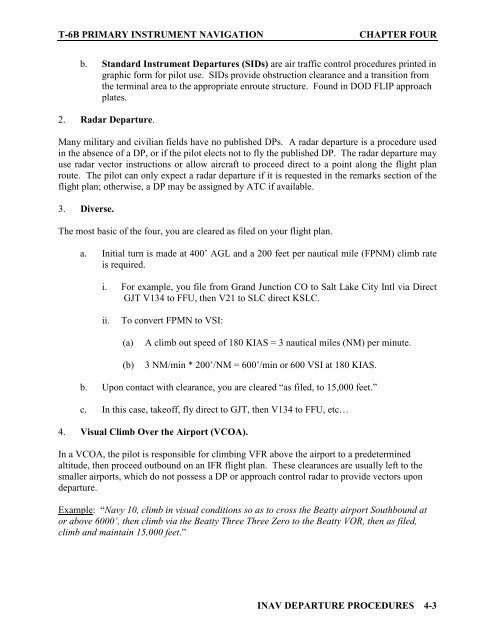Flight Training Instruction - Cnatra - U.S. Navy
Flight Training Instruction - Cnatra - U.S. Navy
Flight Training Instruction - Cnatra - U.S. Navy
You also want an ePaper? Increase the reach of your titles
YUMPU automatically turns print PDFs into web optimized ePapers that Google loves.
T-6B PRIMARY INSTRUMENT NAVIGATION CHAPTER FOUR<br />
b. Standard Instrument Departures (SIDs) are air traffic control procedures printed in<br />
graphic form for pilot use. SIDs provide obstruction clearance and a transition from<br />
the terminal area to the appropriate enroute structure. Found in DOD FLIP approach<br />
plates.<br />
2. Radar Departure.<br />
Many military and civilian fields have no published DPs. A radar departure is a procedure used<br />
in the absence of a DP, or if the pilot elects not to fly the published DP. The radar departure may<br />
use radar vector instructions or allow aircraft to proceed direct to a point along the flight plan<br />
route. The pilot can only expect a radar departure if it is requested in the remarks section of the<br />
flight plan; otherwise, a DP may be assigned by ATC if available.<br />
3. Diverse.<br />
The most basic of the four, you are cleared as filed on your flight plan.<br />
a. Initial turn is made at 400’ AGL and a 200 feet per nautical mile (FPNM) climb rate<br />
is required.<br />
i. For example, you file from Grand Junction CO to Salt Lake City Intl via Direct<br />
GJT V134 to FFU, then V21 to SLC direct KSLC.<br />
ii. To convert FPMN to VSI:<br />
(a) A climb out speed of 180 KIAS = 3 nautical miles (NM) per minute.<br />
(b) 3 NM/min * 200’/NM = 600’/min or 600 VSI at 180 KIAS.<br />
b. Upon contact with clearance, you are cleared “as filed, to 15,000 feet.”<br />
c. In this case, takeoff, fly direct to GJT, then V134 to FFU, etc…<br />
4. Visual Climb Over the Airport (VCOA).<br />
In a VCOA, the pilot is responsible for climbing VFR above the airport to a predetermined<br />
altitude, then proceed outbound on an IFR flight plan. These clearances are usually left to the<br />
smaller airports, which do not possess a DP or approach control radar to provide vectors upon<br />
departure.<br />
Example: “<strong>Navy</strong> 10, climb in visual conditions so as to cross the Beatty airport Southbound at<br />
or above 6000’, then climb via the Beatty Three Three Zero to the Beatty VOR, then as filed,<br />
climb and maintain 15,000 feet.”<br />
INAV DEPARTURE PROCEDURES 4-3
















